Abstract
Herein, we study a method for developing a broad-emission emitter that can emit radiation from the visible light to NIR regions. Firstly, an NIR phosphor’s optical properties (e.g., scattering vs. weight concentration, conversion efficiency, and emission spectra under blue and red light excitation) are investigated. Then, pcW-LEDs encapsulated with NIR down-conversion phosphor samples are prepared to test these optical properties. The results show that pcW-LEDs encapsulated with the NIR phosphor at different weight concentrations of 10.0%, 12.5%, and 15.5%, respectively, emit a broadband emission from 400 nm to 900 nm. The EQE values of the pcW-LEDs encapsulated with NIR phosphor at weight concentrations of 10%, 12.5%, and 15.0% are 26%, 23%, and 19%, respectively. The correlated color temperatures of these samples are 5767 K, 5940 K, and 6068 K, respectively. The obtained radiant fluxes of the samples are 26 mW, 22 mW, and 18 mW, respectively, at an injection current of 50 mA.
1. Introduction
Solid-state lighting (SSL) is a revolutionary technology upgrading the quality of human life. LED devices with visible light emission properties have been proven to possess advantages in terms of color performance, luminous efficiency, lifespan, and energy savings [1,2,3,4]. With the development of semiconductor lighting, the use of light sources on smartphones has become popular. The applications of light sources with white light emission on a smartphone are flexible, e.g., searching for things in the dark, providing light when taking photos at night, or for use as a spotlight. To make white light, smartphones can combine three types of color light-emitting diodes (LEDs): red, green, and blue. However, this method has some drawbacks, such as requiring additional circuit designs to operate these LEDs due to their different forward voltages, nonuniformity in the colors’ spatial distribution, and requiring a large-volume package [5,6,7]. Thus, smartphone designers do not consider them preferable light sources. Another method for making white light is using an LED as an excitation light source to excite luminescent material, which converts the absorbed excitation wavelength to a long and broad emission band. A light source based on this method is called a phosphor-converted white light-emitting diode (pcW-LED). This method satisfies the criteria for smartphone light sources, including a high luminous efficiency, a compact size, a controllable spectrum, a high CRI value, and low power consumption.
Technological innovation tends to bring new useful functions to smartphones. For example, smartphones can now be used to perform spectroscopy, allowing users to find out information about objects, such as fruits, as illustrated in Figure 1. In other words, light absorption allows for determination of the contents of test objects. Smartphone flashlights emit a broadband wavelength (e.g., visible light and near-infrared–visible light). This broadband light illuminates a target object (e.g., a fruit) and is absorbed by the constituents in the object. The reflected light signal from the object is then detected by the smartphone, which assesses the absorbed wavelength region. Referring to a database on the absorption spectra for different chemical substances, which includes information on some dangerous substances, the smartphone can help the user to make a suitable decision. With the development trend of integrating more and more functions into smartphones, there have been many studies focused on researching the flashlights in commercial smartphones [8,9,10,11,12,13,14,15,16]. Vu et al. developed tools for characterizing the temporal and spectral profiles of the flashlights in various smartphones (Apple iPhone 5S, iPhone 6S, iPhone 8, iPhone XR, and Samsung Note8), their torch and flash emissions, and their dependence on the phones’ power states [8]. Butler et al. investigated the effect of different smartphone models’ light sources on image quality to assess the feasibility of utilizing smartphone flashlights as an alternative endoscopic light source. Their results indicated that the iPhone 4 and iPhone 6 consistently underperformed in comparison to the Storz 11301D3 portable light source (p < 0.05), while the Galaxy S6, Galaxy S7, and newer-generation iPhone 8 and iPhone X provided comparable pixel intensities to the Storz 11301D3 portable light. Smartphones incorporate different types of light-emitting diodes. Newer Galaxy and iPhone models provide adequate illumination for endoscopic assessments of the airway, comparable to that of commercially available portable light sources [9]. Fan et al. conducted an investigation wherein the flashlight LED of a smartphone was studied and used as the light source for visible light communication (VLC). Encoding and decoding methods appropriate for the flashlight were proposed and demonstrated. This VLC technique was applied in an access control system that is simple, reliable, convenient, and low-cost, offering a supplement to the conventional access control system [10]. Baskoun et al. studied the feasibility of using smartphones as an alternative light source in endoscopic procedures by comparing them to conventional light sources. Their results showed that the illumination was adequate, and the results obtained with an iPhone 6S were satisfactory [11]. Kimme et al. noted an advantage of the flash LEDs on modern mobile phones, which is the color gamut increase demonstrated by their displays in recent years. The influence of this improvement on the color reproduction of smartphones was investigated based on the CIECAM02 color appearance model, and a metric was introduced to judge the color reproduction of mobile phones under flash LED illumination [12]. Solyman et al. studied the characteristics of the LED flashlights on a sample of smartphone types currently in use by ophthalmologists in Egypt, evaluating their potential for photobiological applications when used in conjunction with a +20-diopter indirect ophthalmoscopy condensing lens for indirect photography of the retina. The LED flashlights of the tested smartphones appeared to be within safe limits when used for indirect smartphone retinal photography. However, the high representation of the short-wavelength blue light spectrum may be a concern, particularly with prolonged and repeated examinations [13]. Pincenti et al. evaluated the LED-based flash solutions used in camera phone applications. The performance of a given flash solution was measured in terms of its color accuracy and signal-to-noise ratio (SNR), both of which are standard test metrics used in the industry. Measuring the color accuracy and SNR provides an evaluation method that builds on developed techniques and offers a practical foundation for flash evaluation in the camera phone industry [14]. Liang et al. reported the fabrication of an affordable, portable, and reliable point-of-care testing (POCT) sensor: a smartphone-based visual POCT platform designed by integrating flashlight illumination and camera imaging functions [15]. Mondal et al. developed a stand for smartphone torches to determine the applicability of smartphone torch-based light sources in microscopy. Their developed smartphone torch stand with an optical diffuser can serve as an emergency light source in microscopy, which is useful for settings with frequent power outages [16]. Nguyen et al. experimentally investigated and evaluated the optical properties of a commercial smartphone’s phosphor-converted white light-emitting diode-based flashlight source. Four types of smartphone flashlights—those in Samsung smartphones, iPhone 6, iPhone 12, and iPhone 13—were selected for their investigation. Their flashlights’ emission spectra showed a visible light wavelength emission band but lacked NIR spectral content [17].

Figure 1.
An illustration of the working principle of broadband-emission smartphone lamp-based spectroscopy applications.
The limitation of a short emission band in the visible region leads to limitations in some applications of spectroscopy or spectrum-based non-invasive testing, raising the need to extend the emission spectrum for LED devices. Many reported works have focused on developing NIR phosphors [18,19,20,21,22], the main properties of which are listed in Table 1. Song et al. developed an NIR phosphor by doping Mn2+ into MgAl2O4 material for applications in high-efficiency NIR light-emitting diodes and night-vision devices [18]. Qiao et al. studied divalent europium element doping to develop NIR phosphors for light-emitting diodes [19]. Xu et al. co-doped Ce3+ and Cr3+ into Y3Al2Ga3O12 host material to obtain persistent NIR multi-wavelength luminescence [20]. Dai et al. synthesized Y3(Al,Ga)5O12 materials doped with Ce3+, Cr3+, and Pr3+ by using a modified Pechini method and investigated the effect of annealing temperatures ranging between 900 °C and 1500 °C on persistent luminescence and NIR emissions [21]. In an application of NIR phosphors, Nguyen et al. conducted an innovative study of a headlamp with a reflector and a mini-LED matrix to emit low and high beams [22]. An NIR phosphor material was applied on the top of the GaN die to emit IR radiation for high beams that can avoid glare effects on other people and light pollution during driving. However, there is still a knowledge gap regarding the optical properties (e.g., scattering and conversion efficiency) of NIR phosphors and packaging configurations; this knowledge is needed to extend phosphor- and LED-based applications.

Table 1.
Activated luminescent materials that emit radiation in the NIR-I region.
In this study, we propose and demonstrate a method to fabricate an emitter with a broadband emission spectrum from a combination of pcW-LEDs and commercial NIR phosphor material. The scattering and conversion efficiency of the NIR phosphor, being important optical properties, are investigated. The emission spectrum of the NIR phosphor under blue and red light excitation is tested. To fabricate the broadband spectrum emitter, pcW-LEDs with different weight concentrations of the NIR phosphor are constructed and tested, enabling a broad emission band in the visible and NIR regions to be detected and analyzed.
2. Design Principle for Broadband-Emission-Spectrum Emitter
The working principle of a broad-emission-band emitter is illustrated in Figure 2. The blue light is covered by two types of phosphor: a yellow phosphor and a near-infrared (NIR) down-conversion phosphor. The yellow light results from the conversion of absorbed blue light [1,2], while the NIR radiation results from the conversion of absorbed blue and red light [3]. There is still a portion of unabsorbed blue light that is transmitted to the surrounding space. As a result, mixing of the transmitted unabsorbed blue light with the converted yellow and NIR radiation is obtained.
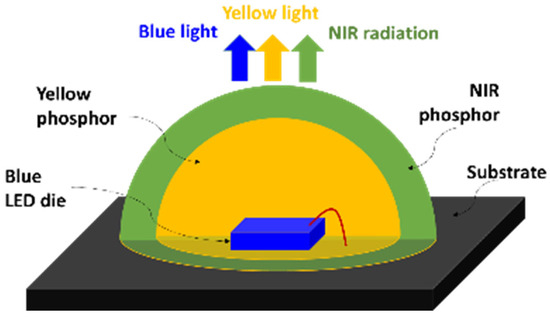
Figure 2.
An illustration of the working principle for a broad-emission-band emitter.
3. Results
Since the available information on the commercial near-infrared (NIR) down-conversion phosphor was not sufficient, a clear understanding of the phosphor material’s composition was required. Therefore, some measurements were conducted to determine this information for the host material and the doping material, including X-ray diffraction (XRD) and X-ray photoelectron spectroscopy (XPS). In principle, the composition of the host material can be easily determined by comparing the sample’s X-ray diffraction (XRD) pattern to the XRD pattern database. However, the concentrations of doped elements may not be high enough; thus, it may be more difficult to define this information using the XRD pattern. For this situation, the XPS measurement method is a suitable option.
Figure 3 presents the XRD results for the near-infrared (NIR) down-conversion phosphor. The diffraction angle (2-theta) was investigated in a range from 10° to 80°. Diffraction peaks were observed at 2-theta values of 17.8°, 20.7°, 27.5°, 29.4°, 33.0°, 34.7°, 36.2°, 37.7°, 40.6°, 42.1°, 46.0°, 52.2°, 54.5°, 55.5°, 56.7°, 60.9°, 69.1°, 71.1°, and 73.1°. These match well with the standard card (ICPDS: No. 089-6660) for Y3Al2Ga3O12 (YAGG); thus, the host material was confirmed as YAGG [23]. In addition, the intense diffraction peaks and narrow peak bandwidth with a FWHM of 0.1° revealed a high crystallinity of the YAGG host material. The highest intensity of the peak at a diffraction angle of 33° indicated that the strongest growth of the crystal was along this orientation.
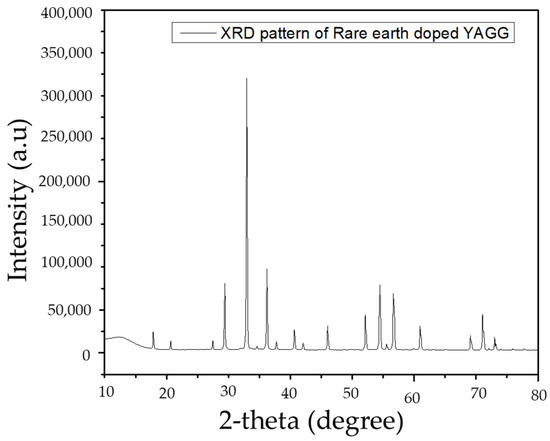
Figure 3.
XRD pattern of rare-earth-element-doped NIR luminescent material.
After the host material was defined as YAGG, the doped elements in the compound were investigated. Based on the emission spectrum of the material, we can determine the range of NIR emission wavelengths from 650 nm to 900 nm. Thus, possible emission spectra of the activated luminescent material in the NIR region from 650 nm to 900 nm were obtained first to define some possible doped elements. Then, XPS measurements were performed to confirm these activated luminescent materials. By combining this information on the host material and activated luminescent materials, the doped materials could easily be determined.
Candidates from the references listed in Table 1 were investigated via XPS. The results were compared with the database of “Handbook of X-ray Photoelectron Spectroscopy: A Reference Book of Standard Spectra for Identification and Interpretation of XPS Data” [24], as shown in Figure 4. Finally, from the results of the XRD, XPS, and PL spectra, the NIR phosphor material in this study was determined to be “YAGG: Cr, Nd, Eu”.
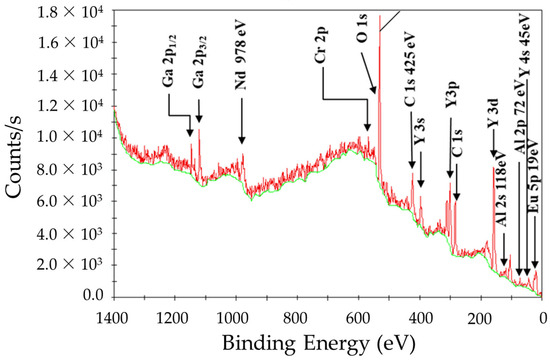
Figure 4.
The investigation of the XPS spectrum for the NIR phosphor material.
It is essential to provide detailed information about the experimental methods and measurements used during a scattering investigation. Firstly, we prepared plates containing different amounts of the NIR phosphor. Different weight concentrations of the NIR phosphor were mixed with silicone gel to make different mixtures. Each mixture was poured into a mold and then cured on a hot plate at 120 °C. After the curing process, each plate was removed from its mold to obtain a finished plate. Secondly, we needed to select a suitable laser source to study the scattering behavior of the plates containing different weight concentrations of the NIR phosphor. A collimating source (i.e., a laser source) was selected to project onto the plate. The laser radiation was incident normal to the plate. A portion was transmitted and scattered forward, another portion was scattered backward, and a negligible amount was absorbed. An optical power meter was used to scan different angles to detect the power at each scattering angle. To ensure a trustworthy result, we selected a suitable wavelength to avoid the fluorescence effect. In other words, using a laser with a suitable wavelength meant that the NIR phosphor did not convert this wavelength into NIR radiation.
As backward scattering can cause significant loss in the packing process, it is important to understand the scattering behavior caused by the NIR phosphor at different weight concentrations. The NIR phosphor was mixed with silicone gel to make plates as shown in Figure 5a. The thickness and diameter of each plate were 0.6 mm and 16 mm, respectively. In this study of the scattering behavior of the NIR phosphor, the selection of the laser wavelength considered its absorption and re-emission by the NIR phosphor, which could affect the accuracy of the scattering behavior results. Considering the absorption of the NIR phosphor, an IR laser diode with a wavelength of 808 nm was chosen to study the effect of the phosphor weight concentration on the scattering behavior of incident radiation. The radiation at wavelength 808 nm, incident normal to the plate, scattered in different directions. The optical power was scanned around the plate to detect this scattered radiation. Figure 5b shows the forward and backward scattering of 808 nm wavelength NIR radiation hitting the NIR phosphor plate. The result shows that for the weight concentration range of 7.5% to 12.5%, the scattering intensity was inversely proportional to the weight concentration of the NIR phosphor.
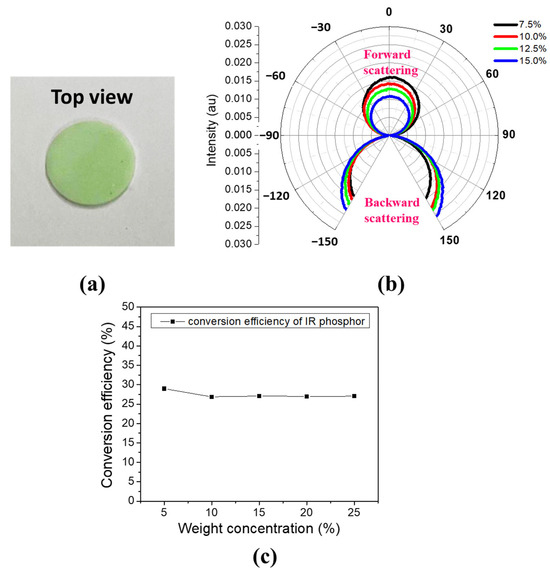
Figure 5.
(a) NIR phosphor plate. (b) Forward and backward scattering of 0.6 mm thick NIR phosphor plate under 808 nm radiation. (c) Conversion efficiency of NIR phosphor under blue light excitation.
For a phosphor material, one of the most important parameters is its quantum yield or internal quantum efficiency. Since this information is usually not provided by the supplier, it is necessary to determine the conversion efficiency information of an NIR phosphor as the ratio of converted NIR phosphor to absorbed excitation radiation. The conversion efficiency of the NIR phosphor under blue light excitation is shown in Figure 5c. For weight concentrations from 10% to 25%, the conversion efficiency was 27%, independent of the weight concentration.
The experimental results on the scattering behavior and EQE data provided meaningful information. For the weight concentration range from 7.5% to 12.5%, the scattering intensity was inversely proportional to the weight concentration of the NIR phosphor. In the packaging field, the generated photons are expected to escape to the outer packaging volume as much as possible; however, backward scattering is an unavoidable phenomenon. Reducing backward scattering can enhance forward scattering, which helps to obtain more useful photons. Understanding the scattering behavior versus the weight concentration of a material helps define a suitable range for the amount of material to be used. This reduces the optical loss due to backward scattering while increasing forward scattering. When electrical power is applied to the device, a portion of this energy is converted into optical power, and the rest is converted into heat. The external quantum efficiency (EQE) provides important information about the efficiency of the device in converting electrical power to optical power: the higher the EQE value is, the more optical power is generated.
Since NIR phosphors have a broad excitation spectrum covering blue light and the red region [3], the emission properties of the NIR phosphor were excited by blue and red LEDs, and their spectra are shown in Figure 6. The peak wavelengths of the blue and red LEDs were 450 nm and 630 nm, respectively. Since the NIR emission spectrum can be generated under the excitation of blue and red LEDs, we must be careful when combining it with a yellow phosphor; this is because the yellow phosphor’s emission spectrum also includes the red light region.
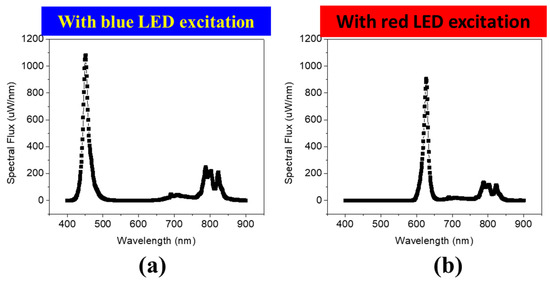
Figure 6.
Emission spectra under two types of LED excitation sources: (a) blue LED; (b) red LED.
After obtaining this information on the NIR phosphor, we prepared some samples that can emit a broad spectrum to study the emission spectrum of the emitter. In detail, pcW-LEDs were covered with NIR phosphor at different weight concentrations of 10.0%, 12.5%, and 15.5%. Figure 7a,b show the sample pcW-LEDs without and with the NIR phosphor covering. Figure 7c,d show the emission spectra of the pcW-LED without the NIR phosphor and the pcW-LEDs encapsulated with NIR phosphor at weight concentrations of 10.0%, 12.5%, and 15.5%. Broadband emission from 400 nm to 900 nm was obtained, as shown in Figure 7d. At the higher weight concentrations of the NIR phosphor, the emission spectrum showed a lower output intensity of the blue and yellow bands, but the emission in the NIR region was not different. This suggests the use of a low concentration of NIR phosphor (i.e., 10% of wt.) to maximize the output of blue and yellow light.
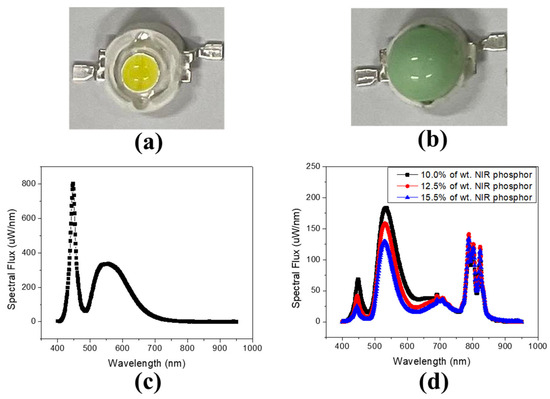
Figure 7.
(a) pcW-LED without NIR phosphor. (b) pcW-LED after encapsulation with NIR phosphor. Emission spectra of (c) pcW-LED and (d) pcW-LEDs after encapsulation with NIR phosphor at different weight concentrations.
The differences in the optical properties of the tested sample pcW-LEDs before and after packaging with the NIR phosphor are shown in Table 2. The pcW-LEDs after packaging with the NIR phosphor showed a lower CCT value than the pcW-LED without the NIR phosphor. This CCT change is related to the power ratios of the blue, green, and red light regions in the output spectrum. There was a large difference in radiant flux between the pcW-LEDs without and with the NIR phosphor. The reason for this difference is that with two kinds of phosphor (yellow and NIR phosphors), the loss is more serious (e.g., losses occur during the wavelength conversion process due to Stoke loss, and the internal quantum efficiency/conversion efficiency of the phosphor material is limited). As a result, combination with the NIR phosphor leads to a significant reduction in external quantum efficiency. Here, the external quantum efficiency (EQE) is the ratio of output radiation optical power to electrical power consumption. The samples were driven at a small injection current of 50 mA to avoid thermal effects. The EQE values of the pcW-LED samples encapsulated with NIR phosphor at weight concentrations of 10.0%, 12.5%, and 15.0% were 26%, 23%, and 19%, respectively.

Table 2.
Optical properties of tested sample pcW-LEDs before and after packaging with NIR phosphor.
Figure 8 shows the evolution of the color performance of the pcW-LED without NIR phosphor and the pcW-LEDs encapsulated with NIR phosphor at different weight concentrations (10.0%, 12.5%, and 15.5%). As the NIR phosphor weight concentration increased, the color point moved to the green region. The chromaticity coordinates of the pcW-LED without NIR phosphor and those with NIR phosphor at weight concentrations of 10.0%, 12.5%, and 15.5% were (0.3103, 0.3211), (0.3209, 0.509), (0.3105, 0.5481), and (0.3022, 0.5698), respectively. This is because the power ratio of green light was higher than those of blue and red light in the spectral composition of the output spectrum. These characteristics can be seen clearly in Figure 7d.
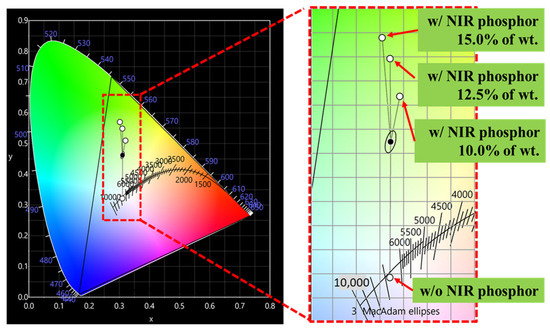
Figure 8.
The color performance of a pcW-LED without NIR phosphor and pcW-LEDs encapsulated with NIR phosphor at different weight concentrations.
To evaluate light source color rendition, Figure 9 shows the color rendering index (CRI) information for the pcW-LED without NIR phosphor and the pcW-LEDs encapsulated with NIR phosphor at weight concentrations of 10.0%, 12.5%, and 15.5%. The corresponding CRI values were 72, 52, 46, and 42, respectively. There is a large difference between the CRI values of the samples with and without NIR phosphor. With the addition of NIR phosphor, the CRI is suppressed compared to that without the NIR phosphor. The reason for this is the decrease in the red light portion in the final spectrum. Red light is absorbed by the NIR phosphor and converted into NIR radiation. However, the CRI can be increased by increasing the red light region (e.g., by adding a red phosphor). In addition, Figure 9 shows the effect of the NIR phosphor in an assessment of the industry standard IES TM-30-18 for color rendering. IES TM-30-18, or the “IES Method for Evaluating Light Source Color Rendition,” presents a new framework for assessing the color rendering capabilities of light sources in terms of their color fidelity and color gamut. The Color Fidelity Index (Rf) metric assesses how accurately a light source renders colors, with an indicator value ranging from 0 to 100. A higher value indicates better fidelity. The color rendering capabilities of a light source are assessed using the Color Gamut Index (Rg), which gives information on the saturation of colors rendered by the light source. Rg values higher than 100 indicate enhanced color saturation. Inversely, desaturated colors correspond to values below 100. In Figure 9a, for the case of the white light spectrum without added NIR phosphor, the color vector graphic (CVG) is distorted from a circular to an elliptical shape. In Figure 9b–d, with increasing NIR phosphor content from 10.0% to 12.5% and 15.0%, respectively, the circular CVG is modified in regions 5, 6, 13, and 14, compared to the reference circle. This distortion indicates a decrease in the fidelity and gamut properties of the light emission spectrum of this light source.
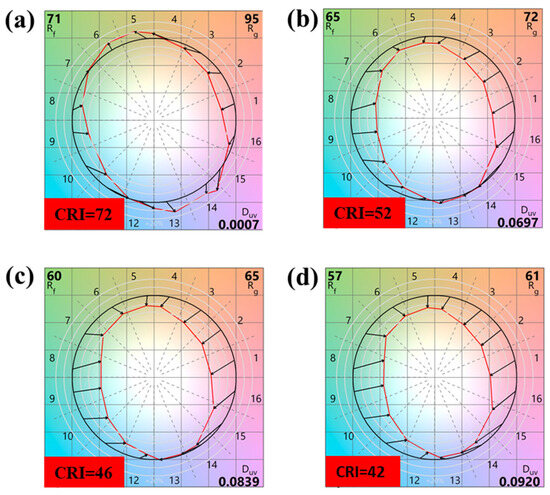
Figure 9.
The CRI values and properties of (a) a pcW-LED without NIR phosphor and pcW-LEDs encapsulated with NIR phosphor at weight concentrations of (b) 10.0%, (c) 12.5%, and (d) 15.5%.
4. Discussion
The study of NIR phosphors and their optical properties is essential for the design and fabrication of efficient broadband wavelength emitters. The unique characteristics of these phosphors enable a wide range of applications across various fields, enhancing technologies for lighting, biomedical sciences, thermal management, and biomedical imaging. This research aimed to understand the optical behavior and efficiency of commercial NIR phosphors and explore their novel applications, paving the way for advancements in optoelectronic devices and related technologies.
A broad excitation spectrum allows for efficient energy transfer from various excitation sources (e.g., UV radiation or visible light) to the phosphor. Depending on the purpose of the output spectrum, the blue and red excitation spectra can be chosen to excite a phosphor to obtain NIR emission.
In this research, two factors provide promising research directions for future work. The first is the large Stokes shift, which is the difference in energy between the absorbed photons and the emitted photons and can cause a significant thermal effect. A larger Stokes shift reduces the chances of re-absorption and the efficiency of photoluminescence. Furthermore, the optical properties of NIR phosphors can vary with temperature, leading to modifications in their emission intensity and spectral position. Understanding this thermal behavior is critical for applications that operate under varying thermal conditions. The second is the limited quantum efficiency (QE), which refers to the ratio of emitted photons to absorbed photons. A high quantum efficiency is desirable as it indicates the effective conversion of absorbed energy into emitted light. The factors that influence QE include the concentration of dopants, the crystal structure, and the presence of non-radiative energy loss mechanisms. Improving the quantum efficiency of NIR phosphors is a valuable research direction for the application of NIR phosphors in the fabrication of broadband wavelength emitters.
The novelty of this manuscript on an Y3Al2Ga3O12 phosphor co-doped with Cr3+/Nd3+/Eu3+ ions lies in our scattering behavior study and QE measurements. Firstly, we consider our scattering behavior study. Few studies have reported the scattering behavior of NIR phosphors. Additionally, it is difficult to study the scattering of NIR phosphors since their excitation is in the visible region. To overcome this limitation, in this study, we innovatively used a laser with a wavelength of 808 nm to investigate scattering; this avoided the luminescence effects that occur when an unsuitable wavelength is used. Few studies have reported on related topics. Secondly, we consider the information in the QE measurements. To the best of our knowledge, in the NIR phosphor field, QE is still a bottleneck since the achieved value is lower than that for yellow phosphors. Thus, QE information is important for understanding the state of the art of NIR phosphor QE. Many researchers continue to contribute to improvements in NIR phosphor QE.
The insufficient information on the thermal stability of the phosphor and pcW-LEDs under operational conditions may raise concerns about their long-term reliability. However, the thermal effect is small when they are operated at a small injection current (i.e., a value smaller than 50 mA). Concerns about long-term reliability are low for small thermal effects; thus, a small injection current is preferred. In the case of high-power applications using a large driven current, a comprehensive report on thermal modeling and testing will be important. Such work is left to future studies.
Near-infrared (NIR) phosphors have high potential in various biological applications due to their unique optical properties. A notable biological application of NIR phosphors is in non-invasive techniques. NIR light penetrates deeper into biological tissues, which can provide clear imaging information in vivo. As a demonstration of this potential application, Figure 10 shows photos of a human hand taken without and with light from an LED encapsulated with NIR phosphor. Figure 10b shows that the NIR radiation enables deep penetration and provides a clear image, which could help to detect the presence of foreign objects.
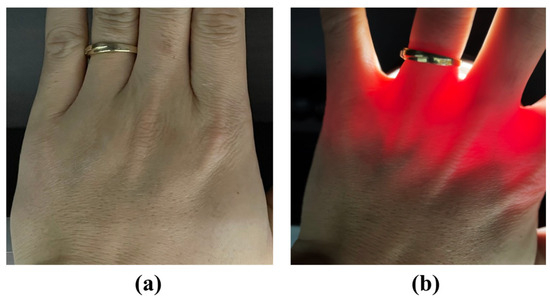
Figure 10.
Photos taken (a) without and (b) with light from an LED encapsulated with NIR phosphor.
5. Conclusions
In summary, we studied a method for developing a broad-emission emitter that can emit radiation from the visible to NIR regions by covering pcW-LEDs with an NIR down-conversion phosphor. A higher weight concentration of NIR phosphor led to strong backward scattering while decreasing the forward scattering intensity. The conversion efficiency under blue light excitation was approximately 27%, requiring improvement. Sample pcW-LEDs encapsulated with NIR phosphor at weight concentrations of 10.0%, 12.5%, and 15.5% were prepared, and their broadband emission from 400 nm to 900 nm was obtained. The amount of NIR phosphor affected the output intensity of blue and yellow light, which suggests that a low weight concentration of NIR phosphor (i.e., 10.0% of wt.) should be considered when developing broadband wavelength emitters. The EQE values of pcW-LED samples encapsulated with NIR phosphor at weight concentrations of 10%, 12.5%, and 15.0% were 26%, 23%, and 19%, respectively. This research is meaningful in promoting the development of broad emission bands for use in the fields of lighting and non-invasive testing.
Author Contributions
Conceptualization, Q.-K.N. and T.-H.-T.V.; methodology, Q.-K.N. and T.-H.-T.V.; formal analysis, Q.-K.N. and T.-H.-T.V.; investigation, Q.-K.N. and T.-N.T.; data curation, Q.-K.N. and T.-N.T.; writing—original draft preparation, Q.-K.N.; writing—review and editing, Q.-K.N. and T.-H.-T.V.; supervision, Q.-K.N.; project administration, Q.-K.N.; funding acquisition, Q.-K.N. All authors have read and agreed to the published version of the manuscript.
Funding
This research is funded by Vietnam National University, Ho Chi Minh City (VNU-HCM), under grant number C2024-18-09.
Institutional Review Board Statement
Not applicable.
Informed Consent Statement
Not applicable.
Data Availability Statement
The original contributions presented in this study are included in the article. Further inquiries can be directed to the corresponding author(s).
Acknowledgments
This research is funded by Vietnam National University, Ho Chi Minh City (VNU-HCM), under grant number C2024-18-09.
Conflicts of Interest
The authors declare no conflicts of interest.
References
- Schubert, E.-F.; Kim, J.-K. Solid-state light sources getting smart. Science 2005, 308, 1274–1278. [Google Scholar] [CrossRef] [PubMed]
- Narendran, N.; Gu, Y. Life of LED-Based White Light Sources. J. Display Technol. 2005, 1, 167–171. [Google Scholar] [CrossRef]
- Schubert, E. Light-Emitting Diodes, 2nd ed.; Cambridge University Press: Cambridge, UK, 2006. [Google Scholar]
- Sun, C.-C.; Nguyen, Q.-K.; Lee, T.-X.; Lin, S.-K.; Wu, C.-S.; Yang, T.-H.; Yu, Y.-W. Active thermal-fuse for stopping blue light leakage of white light-emitting diodes driven by constant current. Sci. Rep. 2022, 12, 12433. [Google Scholar] [CrossRef] [PubMed]
- Nguyen, Q.-K.; Glorieux, B.; Sebe, G.; Yang, T.-H.; Yu, Y.-W.; Sun, C.-C. Passive anti-leakage of blue light for phosphor-converted white LEDs with crystal nanocellulose materials. Sci. Rep. 2023, 13, 13039. [Google Scholar] [CrossRef]
- Singh, P.; Tan, C.-M. Degradation Physics of High-Power LEDs in Outdoor Environment and the Role of Phosphor in the degradation process. Sci. Rep. 2016, 6, 24052. [Google Scholar] [CrossRef] [PubMed]
- Davis, J.-L.; Mills, K.-C.; Bobashev, G.; Rountree, K.-J.; Lamvik, M.; Yaga, R.; Johnson, C. Understanding chromaticity shifts in LED devices through analytical models. Microelectron. Reliab. 2018, 84, 149–156. [Google Scholar] [CrossRef]
- Vu, B.-V.; Lei, R.-W.; Mohan, C.; Kourentzi, K.; Willson, R.-C. Flash Characterization of Smartphones Used in Point-of-Care Diagnostics. Biosensors 2022, 12, 1060. [Google Scholar] [CrossRef]
- Butler, J.-J.; White, S.-F.; Myint, C.-W.-M.; Groves, M.-W. The Feasibility of Utilizing Smartphone Flashlights as an Alternative Endoscopic Light Source in Emergency Situations. Ear Nose Throat J. 2021, 100, NP1–NP6. [Google Scholar] [CrossRef]
- Fan, L.-Y.; Liu, Q.-X.; Jiang, C.-X.; Xu, H.-W.; Hu, J.-Y.; Luo, D.-X.; He, Z.-Y.; Huang, Q.-L. Visible Light Communication Using the Flash Light LED of the Smart Phone as a Light Source and Its Application in the Access Control System. In Proceedings of the 2016 IEEE MTT-S International Wireless Symposium (IWS), Shanghai, China, 14–16 March 2016; pp. 1–4. [Google Scholar]
- Baskoun, Y.; Alami, M.E.; Qanadli, S.D.; Arouch, M.; Taouzari, M. An Innovative Adapter to use Smartphone flashlight as a light source for endoscopy in emergency and LMICs. Int. J. Emerg. Trends Eng. Res. 2020, 8, 808–812. [Google Scholar] [CrossRef]
- Kimme, F.; Brick, P.; Chatterjee, S.; Khanh, T.Q. Optimized flash light-emitting diode spectra for mobile phone cameras. Appl. Opt. 2013, 52, 8779–8788. [Google Scholar] [CrossRef]
- Solyman, O.M.; Hamdy, O.; Abdelkawi, S.A.; Hassan, A.A. Investigating the light emitting diode (LED) flashlight characteristics of a sample of smartphones for its safety in indirect retinal photography. Pan Afr. Med. J. 2022, 43, 15. [Google Scholar] [CrossRef] [PubMed]
- Pincenti, J.; Sheldon, C.; Richards, B.-H.; John, G. Evaluation of LED flash performance for camera phones. Proc. SPIE 2011, 7876, 787612. [Google Scholar]
- Liang, L.; Jiang, Y.; Liu, F.P.; Wu, J.; Tian, L.F.; Zhao, S.L.; Ye, F.G. Smartphone flashlight-triggered covalent organic framework nanozyme activity: A universal scheme for visual point-of-care testing. Sens. Actuators B Chem. 2023, 381, 133422. [Google Scholar] [CrossRef]
- Mondal, H.; Mondal, S.; Das, D. Development and applicability of a smartphone torch based emergency light source for microscopy. Indian J. Pathol. Microbiol. 2020, 63, 258–261. [Google Scholar] [CrossRef] [PubMed]
- Nguyen, H.-T.-A.; Nguyen, Q.-K. An Investigation on the Optical Characteristic of the Phosphor-Converted White Light-Emitting Diodes Based Flash Light Source of Commercial Smartphone. J. Mater. Eng. 2025, 3, 148–156. [Google Scholar] [CrossRef]
- Song, E.H.; Jiang, X.X.; Zhou, Y.Y.; Lin, Z.S.; Ye, S.; Xia, Z.G.; Zhang, Q.Y. Heavy Mn2+ Doped MgAl2O4 Phosphor for High-Efficient Near-Infrared Light-Emitting Diode and the Night-Vision Application. Adv. Opt. Mater. 2019, 7, 1901105. [Google Scholar] [CrossRef]
- Qiao, J.W.; Zhou, G.J.; Zhou, Y.Y.; Zhang, Q.Y.; Xia, Z.G. Divalent europium-doped near-infrared-emitting phosphor for light-emitting diodes. Nat. Commun. 2019, 10, 5267. [Google Scholar] [CrossRef]
- Xu, J.; Tanabe, S.; Sontakke, A.D.; Ueda, J.P. Near-infrared multi-wavelengths long persistent luminescence of Nd3+ ion through persistent energy transfer in Ce3+, Cr3+ co-doped Y3Al2Ga3O12 for the first and second bio-imaging windows. Appl. Phys. Lett. 2015, 107, 081903. [Google Scholar] [CrossRef]
- Dai, Z.F.; Boiko, V.; Grzeszkiewicz, K.; Markowska, M.; Ursi, F.; Hölsä, J.; Saladino, M.L.; Hreniak, D. Effect of annealing temperature on persistent luminescence of Y3Al2Ga3O12: Cr3+ co-doped with Ce3+ and Pr3+. Opt. Mater. 2021, 111, 110522. [Google Scholar] [CrossRef]
- Nguyen, Q.-K.; Lin, Y.-J.; Sun, C.; Lee, X.-H.; Lin, S.-K.; Wu, C.-S.; Yang, T.-H.; Wu, T.-L.; Lee, T.-X.; Chien, C.-H.; et al. GaN-based mini-LED matrix applied to multi-functional forward lighting. Sci. Rep. 2022, 12, 6444. [Google Scholar] [CrossRef]
- Xu, J.; Ueda, J.P.; Tanabe, S. Novel persistent phosphors of lanthanide– chromium co-doped yttrium aluminum gallium garnet: Design concept with vacuum referred binding energy diagram. J. Mater. Chem. C 2016, 4, 4380. [Google Scholar] [CrossRef]
- Moulder, J.F.; Stickle, W.F.; Sobol, P.E.; Bomben, K.D. Handbook of X-Ray Photoelectron Spectroscopy: A Reference Book of Standard Spectra for Identification and Interpretation of XPS Data; Perkin-Elmer Corporation Physical Electronics Division: Eden Prairie, MN, USA, 1992. [Google Scholar]
Disclaimer/Publisher’s Note: The statements, opinions and data contained in all publications are solely those of the individual author(s) and contributor(s) and not of MDPI and/or the editor(s). MDPI and/or the editor(s) disclaim responsibility for any injury to people or property resulting from any ideas, methods, instructions or products referred to in the content. |
© 2025 by the authors. Licensee MDPI, Basel, Switzerland. This article is an open access article distributed under the terms and conditions of the Creative Commons Attribution (CC BY) license (https://creativecommons.org/licenses/by/4.0/).